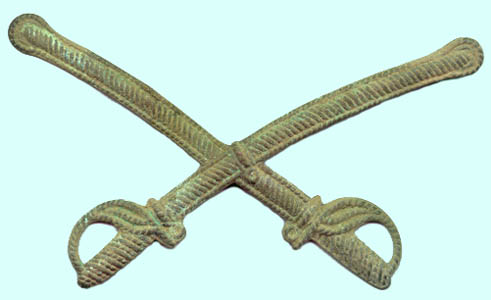Hat Insignia

Cavalry False Embroidered Hat Insignia

A series of brass, false embroidered insignia exist for the major branches of service. These crossed sabers, the insignia of cavalry, were excavated near the Wilderness Battlefield in Virginia. Like many other excavated insignia it is bent. The regimental number may have been placed above the sabers in small false embroidered silver metal numbers. It was worn on the front of the Jeff Davis (Hardee) hat or on the top of the forage cap (kepi). A smaller version of this insignia was worn on the front of the officer forage cap (kepi). Crossed sabers were originally wore by dragoon officers in 1851 on the dress cap (shako) and continue in use by cavalry units throughout the history of the U.S. Army. The majority of crossed sabers were styled with the sabers crossing at the center of the scabbard. The style of the above sabers was less commonly used and has them crossing about a third of the way up from the hilt. The earliest crossed sabers were of this style. During the Civil War both styles were worn in either true or false embroidery with those crossing in the center being the more common type. This insignia may have been intended for officers, but there are many examples of the various metallic, false-embroidered branch insignia being worn my enlisted men.